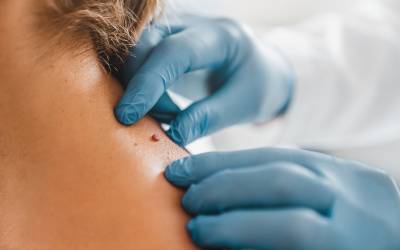UCL Reveals Potential ‘Life-Changing’ Mole Reversal Therapy in Rare Condition Study
The treatment could be used to reverse moles, and therefore prevent affected children and adults from developing cancer. It could also potentially reverse other types of at-risk moles as an alternative to surgery.
Small skin moles are common in the population, but in congenital melanocytic naevus syndrome (CMN), children are born with up to 80% of their body covered in big, painful or itchy moles, caused by genetic mutations acquired in the womb. These moles can develop into a severe type of skin cancer called melanoma.
In the study, published in the Journal of Investigative Dermatology, the researchers blocked a gene called NRAS, which is mutated in the cells in these moles, in cell models and in mice. NRAS belongs to a group of genes (RAS genes) that, when mutated, can cause cancer.
The team used a genetic therapy called silencing RNA, which blocks the action of the mutated NRAS in mole skin cells. The therapy was delivered to mice with CMN in special packages directly to mole cells, via injection.
The expression of the NRAS gene was reduced after just 48 hours.
NIHR Research Professor Veronica Kinsler (UCL Great Ormond Street Institute for Child Health, and GOSH), who is also Principal Group Leader of the Mosaicism and Precision Medicine Laboratory at the Crick, said: “CMN is physically and mentally challenging for children and adults living with this condition and for their families. These results are very exciting, as not only does the genetic therapy trigger self-destruction of the mole cells in the lab, but we have managed to deliver it into the skin in mice. This suggest that the treatment could potentially reverse moles in people.
“We are indebted to our patients at Great Ormond Street Hospital, who have been actively participating over many years to help us produce this new therapy. After more studies in mice, we hope the therapy can soon enter clinical trials in people.”
Jodi Whitehouse, CEO of Caring Matters Now, who helped to fund the research, said: “This breakthrough in finding a treatment for CMN could transform the lives of the families we support living with CMN. As someone who was born with CMN covering 70% of my body and having undergone 30+ operations in my childhood to try and remove the CMN because of the fear of melanoma, with no success, this news is awe-inspiring and exciting. It brings real hope to the lives of those living with CMN.”
This research was funded by the National Institute for Health and Care Research (NIHR), Caring Matters Now Charity and Patient Support Group, LifeArc and the NIHR Great Ormond Street Hospital Biomedical Research Centre.
The researchers have been working closely with the Crick’s Translation team to develop the technology towards patient benefit. This has included securing translational funds from LifeArc, to carry out more research in mice to understand how the treatment works over a longer period.

